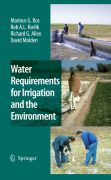
Water requirements for irrigation and the environment
Bos, M.G.
Kselik, R.
Allen, R.G.
Molden, D.
Irrigated agriculture produces about 40% of all food and fibre on about 16% of all cropped land. As such, irrigated agriculture is a productive user of resources; both in terms of yield per cropped area and in yield per volume of water consumed. Many irrigation projects, however, use (divert or withdraw) much more water than consumed by the crop. The non-consumed fraction of the water may cause a variety of undesirable effects ranging from water-logging and salinity within the irrigated area to downstram water pollution. This book discusses all components of the water balance of an irrigated area; evapotranspiration(Ch.2), effective precipitation (Ch.3) and capillary rise from the groundwater table (Ch.4). Chapter 5 then combines all components into a water managementstrategy that balances actual evapotranspiration (and thus crop yield) with the groundwater balance of the irrigated area (for a substainable environment).Discusses all components of the water balance of an irrigated area Presentation of new software CRIWAR 3.0 Contributes to the effective management of one of Earth’s most widely needed, used and wasted natural resources: WATER INDICE: From the contents 1 Introduction. 2 Evapotranspiration. 3 Effective Precipitation. 4 Capillary Rise. 5 Irrigation Water Requirements. 6 Using the CRIWAR Software.
- ISBN: 978-1-4020-8947-3
- Editorial: Springer
- Encuadernacion: Cartoné
- Páginas: 174
- Fecha Publicación: 01/01/2009
- Nº Volúmenes: 1
- Idioma: Inglés
